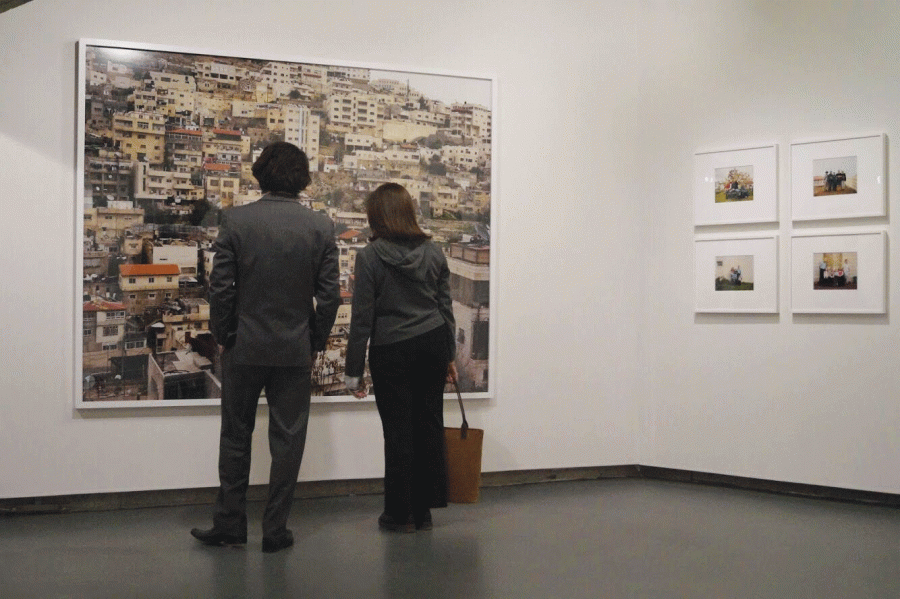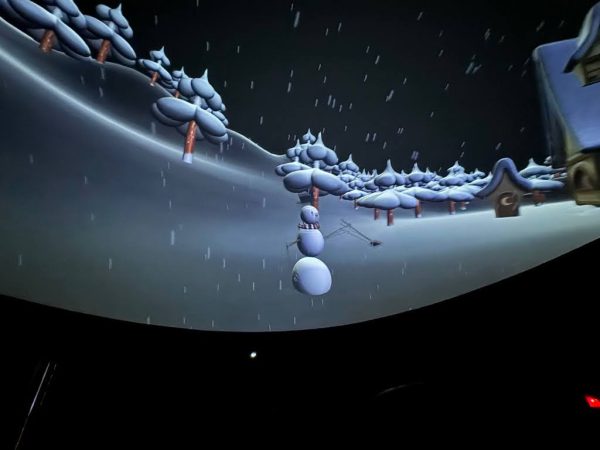Picker Art Gallery Exhibition: “This Place”
Art enthusiasts examine one of the photographs of the Israel or West Bank region in the new exhibit at the Picker Art Gallery.
On Thursday, February 1, a remarkable new exhibit, titled “This Place,” opened in the Picker Art Gallery. “This Place” has been a work in progress for three years and was developed by Frédéric Brenner. It is comprised of the work of 12 international photographers who were invited to travel around Israel and the West Bank and do what they are best at: capture what they see.
This exhibit is split between three other colleges in the upstate New York area: Skidmore College, Hamilton College and the University of Albany. Each school, including Colgate, is showing its quarter of the work from February until May. Faculty members at the gallery are working with professors and the other schools involved to create a bus tour that is intended to take students to the three other schools to see the entirety of the exhibit. The artists presented at Colgate’s Picker Art Gallery include Josef Koudelka, Rosalind Fox Solomon, Thomas Struth and Nick Waplington. At the Picker Art Gallery, an incredible faculty organized by Director of Colgate Museums Anja Chavez worked to set up the exhibit.
Israel and the West Bank are areas that have been highly contested and are populated by people of many races, cultures and religions. Both locations can be threatened by violence at any time as they are regions of conflict. The traveling photographers raise new discussions with their pieces while producing beautiful works of art capturing the culture, landscape, and people of Israel and the West Bank.
“We have a great opportunity to use this as a tool for teaching,” said Nick West, Curator of Collections at the Picker Art Gallery, in his opening remarks.
He expressed that this exhibit will bring everyone together, from art lovers to those interested in foreign happenings. Professors in a variety of fields are planning on working together to pair up students from different disciplines and asking them to attend the exhibit together to stimulate discussion from different points of view.
The opening was celebrated with a wine and cheese reception attended by an audience of all ages. A truly diverse demographic of people came together to enjoy the artwork.
What made this exhibit so intriguing was each photographer’s select style. Seeing how four different photographers could capture Israel and the West Bank from their individual perspectives was fascinating.
“Seeing so many incredible photographs that all look so different and yet are of the same general regions is amazing. I feel like I’m seeing so many new sides of Israel and the West Bank,” first-year Emily Lubin said.
Thomas Struth’s work is the first that you see walking into the exhibit. His photographs are largely of beautiful, colorful landscapes and architecture, but his work has more than just surface meaning. With his art, he intends to show the emotions from a population that can transform a striking landscape.
Josef Koudelka has a very different approach to the project. His melancholy black and white prints stretch out in a glass case down the center of the room and capture the wall separating Israel from the West Bank. This wall has been the subject of much controversy, where one side believes it protects people from attack, while the other sees it as an attempt to control borders. Koudelka traveled along this wall, capturing how it affects the daily lives of the people, the different areas it covers,and the landscape it disturbs.
Photographer Nick Waplington also focused on a controversial topic: the Jewish settlements in the West Bank. These settlements are said to be in violation of international law, but the Israeli government deems them legal. Waplington’s beautiful photographs capture families against fascinating natural landscapes and their homes.
The final artist is Rosalind Fox Solomon. Solomon’s focus is on the people of Israel and the West Bank. She traveled across the regions for months, encountering and capturing an incredible amount of unique people. Her striking portraits cover a sweeping diversity of people that were willing to share their experiences, stories and emotions with her.
The inscription in the gallery introducing Solomon’s work reads,“‘My pictures did not just come out of the camera,’ she says. ‘They came out of my gut.’”
Overall, this striking exhibit showcases four distinct perspectives on the regions of Israel and the West Bank. With its role examining a place with such a complicated history and cultural importance, “This Place” highlights the necessity for us to consider multiple perspectives and the lives of all those living in the region. This is not only an art experience, but an invaluable learning experience for all audiences.
Contact Sasha Balasanov at [email protected].






